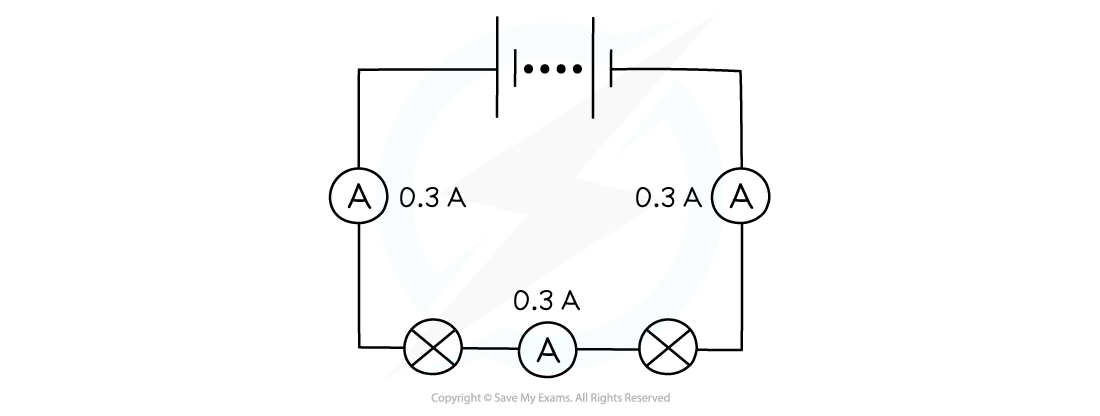Did this video help you?
Current in Circuits (CIE IGCSE Physics: Co-ordinated Sciences (Double Award))
Revision Note
Current in series circuits
What is a series circuit?
- A series circuit contains a single complete loop

In this circuit, the switch, battery and both lamps are in a single loop, making it a series circuit
Current in a series circuit
- In a series circuit, the current is the same value at any point
- This is because the number of electrons per second that passes through one part of the circuit is the same number that passes through any other part
- This means that all components in a closed-loop have the same current

The current is the same at each point in a series circuit
Factors affecting current in a series circuit
- The amount of current flowing around a series circuit depends on two things:
- The voltage of the power source
- The resistance of the components in the circuit
- Increasing the voltage of the power source drives more current around the circuit
- So, decreasing the voltage of the power source reduces the current
- Increasing the number of components in the circuit increases the total resistance
- Hence less current flows through the circuit

Current will increase if the voltage of the power supply increases, and decreases if the number of components increases (because there will be more resistance)
Current in parallel circuits
What is a parallel circuit?
- A parallel circuit consists of multiple loops containing circuit components

The bulbs are each in a separate loop in this circuit, making it a parallel circuit
What is the rule for current in a parallel circuit?
- In a parallel circuit, the current splits along each branch at a junction
- Some of it goes down one branch and the rest goes down the other
- This means that the current from the source is larger than the current in each branch
Lighting circuits
- A lighting circuit is used to supply power to multiple light sources
- Office lights are a common example, as multiple identical bulbs must have the same brightness
- Lighting circuits are constructed in parallel because:
- Bulb's all have the same potential difference and therefore the same brightness
- If one bulb breaks, the rest continue to function as current passes along each branch independently
- This also means lamps can be switched off and on individually without breaking the whole circuit
Calculating current in parallel circuits
Extended Tier Only
- The current before a junction is equal to the sum of currents along each branch after the junction

Current from the power supply (4 A) is split along each branch (2 A). These current combine again at the other side
- At a junction in a parallel circuit (where two or more wires meet) the current is conserved
- This means the amount of current flowing into the junction is equal to the amount of current flowing out of it
- This is because charge is conserved
- Note that the current does not always split equally – often there will be more current in some branches than in others
- The current in each branch will only be identical if the resistance of the components along each branch are identical
- Current behaves in this way because it is the flow of electrons:
- Electrons are physical matter – they cannot be created or destroyed
- This means the total number of electrons (and hence current) going around a circuit must remain the same
- When the electrons reach a junction, however, some of them will go one way and the rest will go the other

Current is split at a junction into individual branches
Worked example
In the circuit below, ammeter A0 shows a reading of 10 A, and ammeter A1 shows a reading of 6 A. What is the reading on ammeter A2?
What is the reading on ammeter A2?
Answer:
Step 1: Recall that at a junction, the current is conserved
- This means that the total amount of current flowing into a junction is equal to the total amount flowing out
Step 2: Consider the first junction in the circuit where current splits
- The diagram below shows the first junction in the circuit

Step 3: Calculate the missing amount of current
- Since 10 A flows in to the junction (the total current from the battery), 10 A must flow out of the junction
- The question says that 6 A flows through ammeter A1 so the remaining current flowing through ammeter A2 must be:
10 A − 6 A = 4 A
- Therefore, 4 A flows through ammeter A2
Examiner Tip
The direction of current flow is important when considering junctions in a circuit. You should remember that current flows from the positive terminal to the negative terminal of a cell / battery. This will help determine the direction current is flowing round a circuit.

You've read 0 of your 5 free revision notes this week
Sign up now. It’s free!
Did this page help you?
